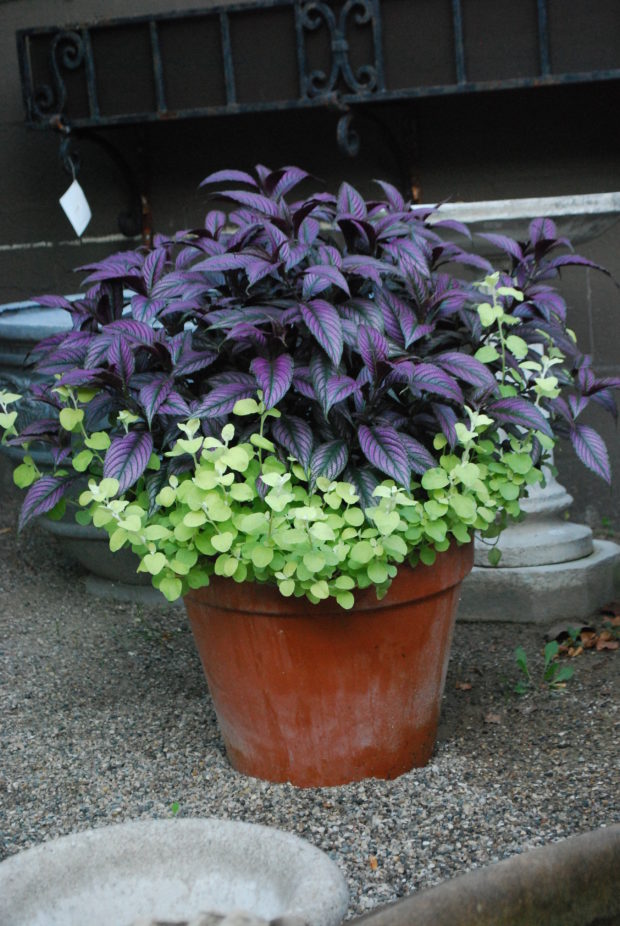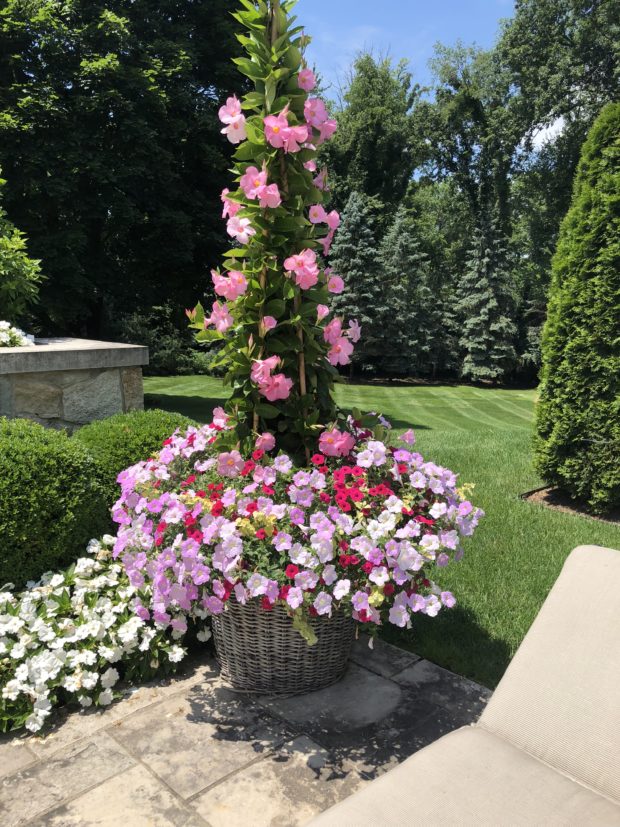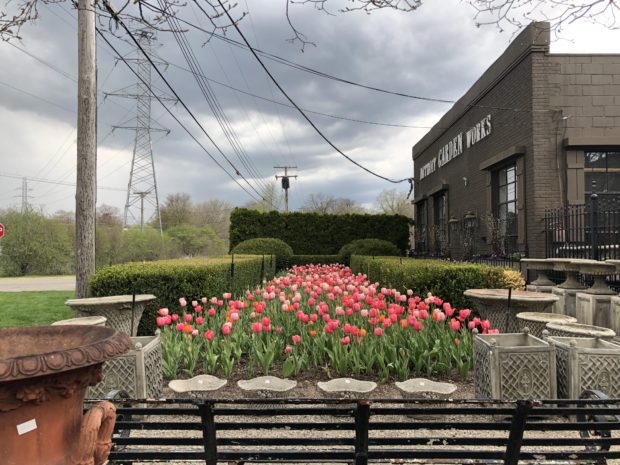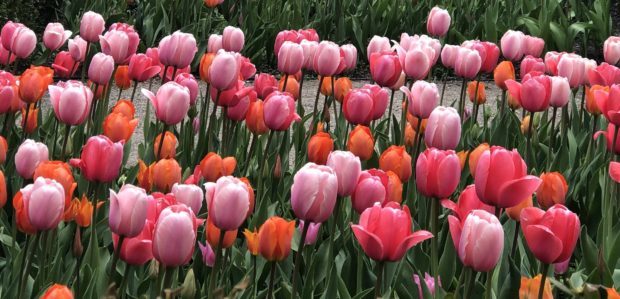 Strictly speaking any object that can hold soil and permit water to drain away constitutes a container. The choices are infinite, really. A container planting that considers the size, shape and style of the container as an essential part of the overall effect is especially beautiful to my eye. A choice of container represents a gardener’s point of view as much as the plants they choose. If a cottage garden, and the notion of farm to table enchants you, then a collection of vintage pails, washtubs and crates planted up with flowers and herbs will help to make that point of view visually stronger. If the architecture of your home is clean, crisp and contemporary, then pots of that ilk will look right at home.
Strictly speaking any object that can hold soil and permit water to drain away constitutes a container. The choices are infinite, really. A container planting that considers the size, shape and style of the container as an essential part of the overall effect is especially beautiful to my eye. A choice of container represents a gardener’s point of view as much as the plants they choose. If a cottage garden, and the notion of farm to table enchants you, then a collection of vintage pails, washtubs and crates planted up with flowers and herbs will help to make that point of view visually stronger. If the architecture of your home is clean, crisp and contemporary, then pots of that ilk will look right at home.
 If a whiff of history is your idea of a great fragrance, then antique or reproduction antique pots will serve your point of view well. If a planting that flows over the edges of a pot all the way to the ground represents your style and and sense of beauty, then go for simple containers that afford plenty of planting square footage for your sprawling plants. This is all by way of saying that taking the time and effort to find containers that strongly appeal to your aesthetic and style of gardening is time well spent. An enthusiasm for your containers is infectious. It will not only inspire your design and choice of plants, but it will be an insistent call to keep your plantings healthy and growing.
If a whiff of history is your idea of a great fragrance, then antique or reproduction antique pots will serve your point of view well. If a planting that flows over the edges of a pot all the way to the ground represents your style and and sense of beauty, then go for simple containers that afford plenty of planting square footage for your sprawling plants. This is all by way of saying that taking the time and effort to find containers that strongly appeal to your aesthetic and style of gardening is time well spent. An enthusiasm for your containers is infectious. It will not only inspire your design and choice of plants, but it will be an insistent call to keep your plantings healthy and growing.
 Choose containers that are suited to their placement. Pots on the front porch need to be proportional to the size of the porch an entry way. Front porch pots and plantings that compliment the architecture and can be seen from the sidewalk are welcoming. Pots on an outdoor dining terrace should be scaled such that the plantings are near eye level to seated guests. Containers that screen an untoward view get a leg up from some extra height and width. A container on an outdoor dining table should be low enough to encourage conversation back and forth. A container set in the landscape needs to have sufficient size and interest to stand out, and command attention. A great pot can provide a little pomp and circumstance to an awkward garden transition.
Choose containers that are suited to their placement. Pots on the front porch need to be proportional to the size of the porch an entry way. Front porch pots and plantings that compliment the architecture and can be seen from the sidewalk are welcoming. Pots on an outdoor dining terrace should be scaled such that the plantings are near eye level to seated guests. Containers that screen an untoward view get a leg up from some extra height and width. A container on an outdoor dining table should be low enough to encourage conversation back and forth. A container set in the landscape needs to have sufficient size and interest to stand out, and command attention. A great pot can provide a little pomp and circumstance to an awkward garden transition.
 I recommend containers with substantial planting area. A decent amount of dirt space means an idea about color, texture, mass and contrast can be thoroughly explored. This is not to say that a tall oval glazed pot with room only for one 8″ pot can’t carry the day. It can. It is the gardener that has to choose the pot that best represents the style they wish to convey. I like lots of room, so I can put together a collection of seasonal plants that have enough room to grow up together, interact, and shine.
I recommend containers with substantial planting area. A decent amount of dirt space means an idea about color, texture, mass and contrast can be thoroughly explored. This is not to say that a tall oval glazed pot with room only for one 8″ pot can’t carry the day. It can. It is the gardener that has to choose the pot that best represents the style they wish to convey. I like lots of room, so I can put together a collection of seasonal plants that have enough room to grow up together, interact, and shine.  Big containers mean a big soil mass. Large pots make it easier to maintain a sufficient moisture level throughout the heat of the summer. A pot that will forgive you if you are late taking up the hose is a pot worth having. Small pots that need water several times a day would not work for me. I work long days, and coming home to a container whose plants are flopped over from lack of water makes my stomach churn. Water stressed plants stress me. Big pots? Bring them on.
Big containers mean a big soil mass. Large pots make it easier to maintain a sufficient moisture level throughout the heat of the summer. A pot that will forgive you if you are late taking up the hose is a pot worth having. Small pots that need water several times a day would not work for me. I work long days, and coming home to a container whose plants are flopped over from lack of water makes my stomach churn. Water stressed plants stress me. Big pots? Bring them on.
 Knowing the gardener in you through and through should inform your choice of pots. A beautiful pot is a sculpture that invites the addition of plants to complete its beauty. Or not. A beautiful pot, sitting empty in a landscape, can be breathtaking. Great pots can be addressed by a gardener any number of ways. But no matter the planting or the not planting, that pot is an ornament for the garden that should be a treasure.
Knowing the gardener in you through and through should inform your choice of pots. A beautiful pot is a sculpture that invites the addition of plants to complete its beauty. Or not. A beautiful pot, sitting empty in a landscape, can be breathtaking. Great pots can be addressed by a gardener any number of ways. But no matter the planting or the not planting, that pot is an ornament for the garden that should be a treasure.
 A collection of great pots can be had all at once, or assembled over a period of time. Some great pots are inherited, or come from a county flea market. Others have been stowed away in a shed, unused, for years. Still others can be repurposed from a kitchen or barn. The pots pictured above are made from recycled tires.
A collection of great pots can be had all at once, or assembled over a period of time. Some great pots are inherited, or come from a county flea market. Others have been stowed away in a shed, unused, for years. Still others can be repurposed from a kitchen or barn. The pots pictured above are made from recycled tires.
 Recycled containers, especially those made from galvanized metal, are a favorite of Rob’s. They are a great addition to a cottage style garden. They look equally at home in a more contemporary setting. The steel in these vintage containers is much thicker and more weather resistant than sheet metal containers being manufactured now. Will these eventually show signs of the galvanized layer wearing thin? Probably. But considering that these are already in excess of 40 years old, I don’t see that happening any time soon.
Recycled containers, especially those made from galvanized metal, are a favorite of Rob’s. They are a great addition to a cottage style garden. They look equally at home in a more contemporary setting. The steel in these vintage containers is much thicker and more weather resistant than sheet metal containers being manufactured now. Will these eventually show signs of the galvanized layer wearing thin? Probably. But considering that these are already in excess of 40 years old, I don’t see that happening any time soon.
 Vintage and reproduction pots can have just as much charm as antique ones-especially if they have been outdoors long enough to have acquired a patina of lichens or moss. The lichens on the rim of this vintage pot will spring back into action, as soon as they are exposed to weather.
Vintage and reproduction pots can have just as much charm as antique ones-especially if they have been outdoors long enough to have acquired a patina of lichens or moss. The lichens on the rim of this vintage pot will spring back into action, as soon as they are exposed to weather.
 Weathering is an inevitable consequence of being outdoors. Any surface which absorbs water can provide a foothold for colonies of small plants. For those gardeners who like a clean look, choose pots with a surface that resist the weather. Glazed or enameled pots do not absorb water from the outside. They can easily be cleaned with soap and water. Pots that do not absorb water do not breathe. This means water only evaporates from the surface of the soil that is exposed at the top. This is a good choice of container for the gardener who has a long list of responsibilities besides watering every day. I helped such a gardener pick pots some years ago. She fills a collection of waterproof containers every year with waterlilies, lotus and floater plants.
Weathering is an inevitable consequence of being outdoors. Any surface which absorbs water can provide a foothold for colonies of small plants. For those gardeners who like a clean look, choose pots with a surface that resist the weather. Glazed or enameled pots do not absorb water from the outside. They can easily be cleaned with soap and water. Pots that do not absorb water do not breathe. This means water only evaporates from the surface of the soil that is exposed at the top. This is a good choice of container for the gardener who has a long list of responsibilities besides watering every day. I helped such a gardener pick pots some years ago. She fills a collection of waterproof containers every year with waterlilies, lotus and floater plants.
 The right pots? You’ll know when you see them, and can’t forget about them.
The right pots? You’ll know when you see them, and can’t forget about them.




















